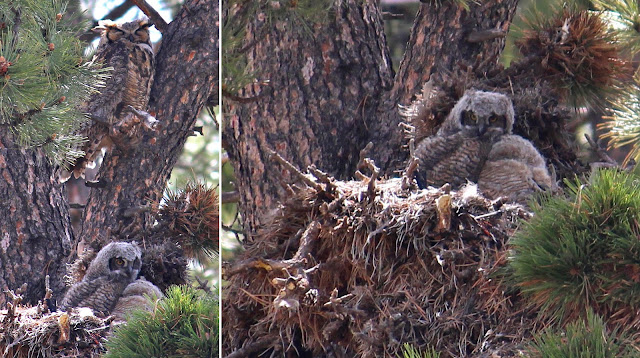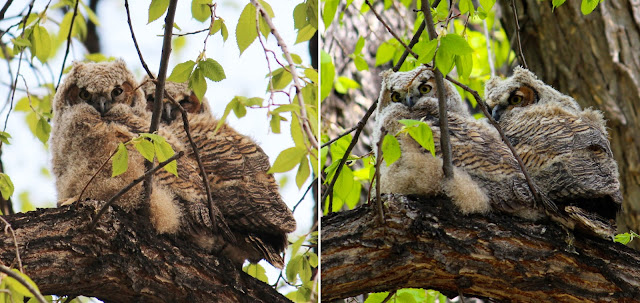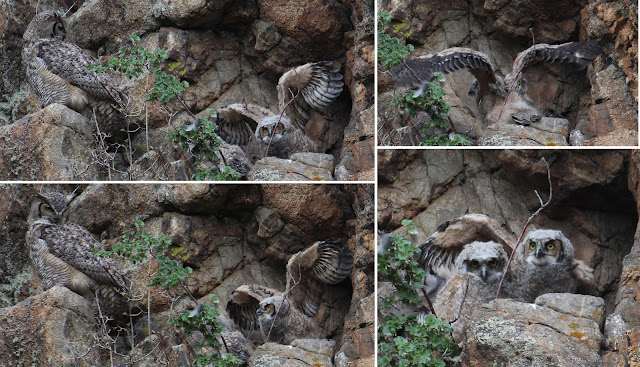We started in Fort Collins, where we went to the cemetery to check out the nest there. The two "chicks" were out of the nest, but not yet flying.
Mom was watching from a tree across the way.
 |
| Watchful parent |
Then, we headed off for Estes Park and Rocky Mountain National Park to see two more nests there.
We were pleasantly surprised to have a rare sighting of male Bighorn Sheep just outside Estes Park. The Bighorn is the symbol of RMNP, but in recent years we just don't see them. There were nine in the group we saw.
 |
| Majestic |
Continuing on into the Park, we were thrilled to see that the Great Horned Owls were still in the nest by the Cascade Cottages (just inside the Fall River entrance).
 |
| The huge nest is in a big pine tree |
Owls are so fascinating - and we spent a long time photographing them.
Quite a few people also stopped to photograph.
 |
| Left, a parent sits above the nest; right, fluffy, downy Owlets |
It's a beautiful spot with good parking opportunities - and, for many, photographing these Owls is an annual activity.
A Walk and on to Estes Park
We took a quick walk around Sprague Lake (we had heard there were Moose there, but didn't see any). It was windy, but lovely.
 |
| Lots of snow still on the mountains |
Then, back to Estes Park to check out the nest behind the municipal library in town. This nest is quite different because it is built into the side of a small cliff.
 |
| The cliff is right behind the parking lot |
Once again, no disappointment. Momma and babies were putting on a show ...
 |
| Two fairly good-sized young 'uns |
The Owlets looked like they were rapidly outgrowing the nest. They were stretching and vigorously flapping their wings, which were still sprouting feathers needed for flight.
The flapping indicated that the chicks would fledge soon, so we were glad we went.
 |
| Even youngsters have a prodigious wingspan (tough in a tight spot) |
When Mom tired of the antics, she flew to a cliff where she cold get some rest, but keep an eye on the babies. Dad, who was in a tree across the way, flew to the cliff and kept watch, as well.
 |
| Left, mom; right, much more red-colored dad |
The Great Horned Owl is the most common Owl in the Americas, recognizable because of the feather tufts on its head that look like horns.
The third largest Owl in America (behind the Great Gray and the Snowy), Great Horned Owls are 18-24 inches tall, weigh from 2 to 5.5 lbs. and have a 3 to 5 foot wingspan. Like many raptors, females are larger than males.
Their color can range from very light gray to dark orangy brown.
Great Horned Owls live from the Arctic to South America in woods, farmlands and neighborhoods. Northern Owls migrate in winter, but most live permanently in temperate areas.
They nest in tree holes, stumps, caves or abandoned nests of other large birds. Monogamous pairs have one to five eggs (two is typical -- all three that we saw had two), both the male and female incubate, and the male also hunts for food.
 |
| There are two in the nest |
Not all eggs are laid at the same time, so sometimes Owlets hatch at different times and are quite different in size.
Owls are powerful and fiercely protective of their chicks. They have even been known to attack humans who wander too close to their young (surprising we didn't see any attacks!).
 |
| Mom tending the Owlets (we didn't see them eat) |
They hunt at night, striking from above and using their talons to kill and carry animals often several times heavier than themselves. They prey on a huge variety of creatures, including Raccoons, Rabbits, Squirrels, Skunks, Birds, Falcons and other Owls.
 |
| These parents have also been known to bring in a housecat |
They sometimes swallow their prey whole and later regurgitate pellets composed of bone, fur and the other unwanted parts of their meal. Or, they rip the prey apart. They feed their babies with the kill rather than regurgitating.
They are silent in flight, but quite vocal - the females and males have different hoots.
 |
| Begging or singing? Hard to tell |
They live 5 to 15 years.
As the light failed, we had a lovely Italian dinner at Mama Rose's and then returned to civilization.
What a thrill to see such magnificent animals!!!
Trip Date: May 18-19, 2014



Yay!
ReplyDeleteyour Pictures and blog are absolutely wonderful and informative and most of all appreciated,...thanks for sharing.....
ReplyDelete